Written by Lisa Asuncion
The United Kingdom might not be the first place that comes to mind when you think of cuisine, but it has a few delightful surprises that every food enthusiast or traveler would surely love!
So, when I found out my friend is visiting London this year, I compiled a list of quintessentially British desserts for her to try, which I’d also love to share with those who might be traveling to the country. Here are five must-try desserts When In London:
Banoffee/banoffi pie
This world-famous pie, featuring a sweet crust, rich toffee, creamy bananas, and coffee-flavored whipped cream, is often thought to have been invented in America, but it’s actually British! Originally called Signor Banoffi’s Pie, it was created by Nigel Mackenzie and Ian Dowding in 1972.
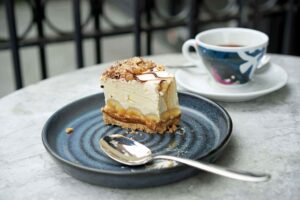
Photo: Lisa Asuncion
It served as a clever reinvention of the coffee toffee pie of Blum’s Bakery of San Francisco. The tweaks Nigel and Ian included were boiled condensed milk soft toffee and bananas. These game-changing recipe alterations elevated this dessert to the legendary status it holds today, and it’s no wonder it’s often copied by other restaurateurs.
Where to have some: Perhaps surprisingly, Banoffee/banoffi pie is not so easy to find on the dessert menus of London restaurants. They’re most often sold as whole pies in bakeries or the frozen dessert section of some supermarket chains. However, if you’re ever in Camden experiencing the punk scene or exploring the streets where legends like Suggs and Amy Winehouse used to walk, you can try this internationally renowned British dessert at Haché Burgers.
Although their version doesn’t come with the traditional sweet crust pastry, it’s delightful nonetheless. It has lots of bananas, as it should, with just the right amounts of toffee and coffee cream, and the nut topping adds a pleasing crunch. Those who know their way around a kitchen can make it at home following the original The Hungry Monk recipe here.
Scones
Scones are a beloved British afternoon tea treat, traditionally served with clotted cream and strawberry jam with a similar texture to a biscuit but not as rich. Pronounced as if it were spelt “scons”, with a short “o” and without the “e”, these are thought to have originated in Scotland in the 1500s.
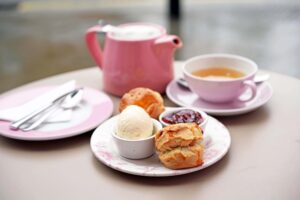
Photo: Lisa Asuncion
Did you know there is a long-standing debate between Cornwall and Devon, the two main producers of clotted cream, as to the correct way to eat a scone? Cornish etiquette dictates that the jam is spread onto the scones first, then clotted cream is put on top. In Devon, it’s the opposite. I don’t know why there is a disparity. I’m not sure anyone really does, but I recommend trying both ways, just to be sure! If you would like to enjoy your scones as the late Queen Elizabeth II had hers, then it’s the Cornish way.
Where to have some: Thankfully, there is no shortage of places to have a cream tea or a traditional English afternoon tea to suit a range of budgets, such as Peggy Porschen, Fortnum and Mason, Harrods, The Wolseley, Claridge’s, The Ritz London, among many others.
Supermarket chains also sell scones, but the clotted cream and jam will have to be bought additionally. You can also try scones with sultanas (a type of raisin) or a savory version with cheese. For a sultana scone recipe fit for royalty, try this.
Sticky toffee pudding
A ubiquitous dessert in English pubs, sticky toffee pudding is a dense sponge cake with puréed and chopped dates, topped with a toffee sauce, and served with either cream, custard, or vanilla ice cream. Its origin is controversial, with many people keen to claim fame for its invention, but the truth remains elusive.
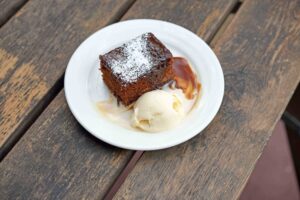
Photo: Lisa Asuncion
I suppose it doesn’t matter which country invented the sticky toffee pudding because it is the British, in particular, its loyal guardians in Cumbria, who have been its avid promoters continue to champion this dessert.
Where to have some: The good news is that all supermarket chains carry sticky toffee pudding, and they typically come in single servings. If you happen to be strolling through the Italian Gardens of Hyde Park, cross the street and try one at The Swan – their version is absolutely delicious. The cake is dense but not stodgy, and it’s also not cloyingly sweet, probably because the toffee sauce is served on the side and not drizzled copiously on top.
It’s served warm with a scoop of vanilla ice cream and is the perfect pudding to enjoy on their terrace or balcony bar while relishing in people-watching and admiring the great views of Hyde Park. Alternatively, you can try following the recipe of legendary British baker Mary Berry here.
Crumble
The first sighting of an apple crumble recipe was in a cookbook titled War-time Cookery Book by Marguerite Patten, published in 1924. The scarcity of ingredients after World War II made it more popular than apple pie, as the pie crust would have used too many precious ingredients. The humble crumble is a no-frills, stripped-down version of the apple pie, another British creation (yes, it’s true – America’s patriotic pie is an import from the British Isles). The crumble has retained popularity even after the war, probably because it’s so simple to prepare.
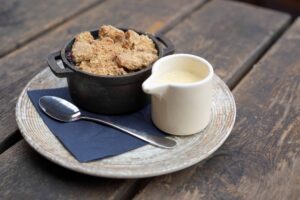
Photo: Lisa Asuncion
The classic crumble is made with Bramley apples, a British cooking apple variety. Bramleys make the best crumble because they have a tart and strong apple flavor and break down when cooked. Crumble fillings can veer away from the classic apple, and the combination of apple and blackberry is prevalent.
Where to have some: Apple crumble is available in supermarkets and most London pubs. For a bespoke takeaway option, head to one of the many Humble Crumble branches. The one at Borough Market is easily accessible, but prepare for long queues!
Meanwhile, The Swan at Hyde Park serves a moreish crumble and vanilla bean custard with a slightly tart apple and blackberry filling topped with a perfectly baked, golden brown crumble topping. If you’re new to baking, this recipe should be easy to follow.
Treacle tart
The treacle tart is probably the most-mentioned pudding in British literature and movies. After all, it’s Harry Potter and Dr. Dolittle’s favorite! It made an appearance in Alice in Wonderland and the Agatha Christie novel 4.50 from Paddington. It was even mentioned in the script of the film Chitty Chitty Bang Bang and the international hit TV series Downton Abbey. The tart that has enchanted writers since the late 19th century was also one of the late Queen Mother and Queen Elizabeth II’s favorite desserts.
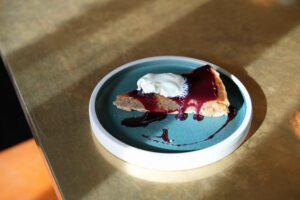
Photo: Lisa Asuncion
The name treacle tart can be misleading because the recipe uses golden syrup, but in the United Kingdom, golden syrup is also called light treacle. Treacle tart is chewy and sweet. To me, it tastes similar to a Filipino casuy (cashew) boat tart without the casuy or a pecan tart without the pecans.
Where to have some: Just like banoffee pie, treacle tart is not commonplace on the menus of London restaurants. Harry Potter fans who find themselves in Covent Garden can step away from the sometimes maddening crowds and take a short five-minute walk to the quieter Bow Street, where the Marquess of Anglesey pub is located.
Their treacle tart is served warm with clotted cream and sloe jam (fruit of the blackthorn tree), which superbly balances the sweetness. To eat treacle tart like a queen, follow the royal recipe revealed by Des Sweeney, former chef to the Royal Family.
There are many other drool-worthy British desserts, such as Victoria sponge, bread and butter pudding, Eton mess, trifle, fairy cake, Bakewell tart, and Eccles cake, to name but a few, and it’s definitely too long a list to cover here. This makes me wonder: Should the United Kingdom really be called the Dessert Kingdom?




